|
|||||||||
|
NEW SCHOLARSHIPBook Review: REPORTING WITH HINDSIGHT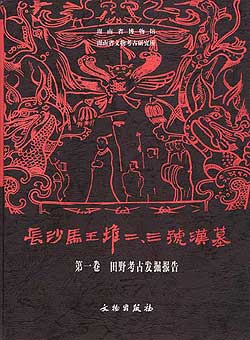 Illustration 1. Cover of recently published report
Illustration 1. Cover of recently published report
Hunan-sheng Bowuguan (Hunan Provincial Museum) and Hunan-sheng Wenwu Kaogu Yanjiusuo (Hunan Provincial Cultural Relics and Archaeology Institute), Changsha Mawangdui er, san hao Han mu (The Number 2 and Number 3 Han Tombs at Mawangdui, Changsha), vol. 1, Tianye kaogu fajue baogao (Report on the archaeological field excavation), Beijing: Wenwu Chubanshe (Cultural Relics Publishing House), July 2004, 394 pages + 48 pages of colour plates + 96 pages of black and white plates  Illustration 2. Mawangdui, Han tomb no. 1, coloured painting on silk (bohua).
Illustration 2. Mawangdui, Han tomb no. 1, coloured painting on silk (bohua).
The discovery and excavation in 1972 of Han dynasty tomb no. 1 at Mawangdui, a hill site in the city of Changsha, capital of Hunan, created an international archaeological sensation. The tomb's well-preserved female corpse and nearly two thousand exquisite funerary objects were documented in the two-volume excavation report prepared by the Hunan Provincial Museum and the Institute of Archaeology of the Chinese Academy of Sciences and published in 1973. Among the finds in tomb no. 1 which captured the world's imagination were: an elaborately painted coffin, covered with an iconography described in the excavation report; a T-shaped painting on silk, described in the report as a painting related to a pennant or wall hanging, (see illustration 2); exquisite fine silk fabrics of a technical level not previously seen; highly refined lacquer objects, including a lacquer screen; musical instruments (se, yu and, yulu); a series of wooden painted figurines; 48 inscribed bamboo plaques denoting foods and other substances; wooden and wicker objects, and 312 bamboo slips. The latter were transcribed in the early excavation report and described as being only the fourth set of inscribed slips found in China since 1949. The finds in Mawangdui Han tomb no. 1 were invaluable for investigating the early history of Chinese technology, medicine, music, cuisine, textiles, clothing, painting, and, of course, funerary customs. The rich imagery provided by the "hanging" painting enabled contemporaries to imagine that they could visualise the spiritual world inhabited by the female tomb occupant (see illustration 3), see an image of the tomb occupant herself (see illustration 4), and view a sacrifice being prepared for her (see illustration 5). The spiritual world of the kingdom of Chu as envisioned on the coffin and paintings on silk from tomb no. 1 was used extensively by Chinese scholars examining the imagery of the literature of Qu Yuan and other early southern Chinese writers in the anthology Chu ci (known in English as Songs of the South). Over the past thirty years, there have been many developments in the reading of tomb illustrations, and the interpretation of the meaning of the various elements in the illustrations can now be related to the wall painting sequences that decorate tombs later in the Han period. The function of this famous ancient Chinese painting is now better understood. 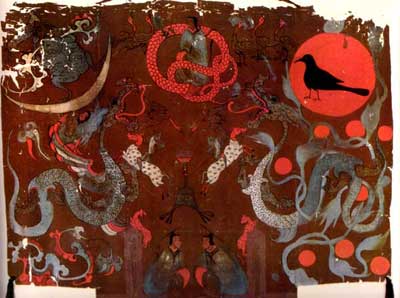 Illustration 3. Mawangdui, Han tomb no. 1, detail of coloured painting on silk (bohua).
Illustration 3. Mawangdui, Han tomb no. 1, detail of coloured painting on silk (bohua).
The greatest textual rewards for Chinese scholars were yet to come from Mawangdui when the two other tombs in the vicinity of tomb no. 1 – tombs nos. 2 and 3 – were excavated by the Hunan Provincial Museum from the autumn of 1973 to the beginning of 1974. The report of this later excavation did not appear until last year, more than thirty years after the excavation, even though the contents of tomb no. 3 were richer than those of tomb no. 1. For Sinologists and all scholars examining the textual record of Chinese civilisation, the finds in tomb no. 3 represent the largest documentary find since the ancient discoveries of versions of the classics in the walls of the Confucius Family Household and of bamboo documents at Jizhong, and the discovery a century ago of the Dunhuang Library Cave and its contents. In 1975 a report in the journal Kaogu (1975:1) stated that a total of more 20 books on silk were found in tombs nos. 2 and 3 at Mawangdui, but in reports in subsequent issues of the journal the quantity of texts had increased to more than 30. The most complete official report on the contents of the texts found in Mawangdui tombs nos. 2 and 3 to appear prior to the publication of the new excavation report last year was Han Zhongmin's article "Changsha Mawangdui Han mu gaishu" (An overall description of the Han tombs at Mawangdui, Changsha), which was published in Wenwu, 1974:9. Fortunately for scholars, some of the writings on silk found in tomb no. 3, notably the documents designated Laozi, Jingfa (Legalist texts) and Zhanguo zonghengjia shu (Writings of the Warring States Strategist school), were published by Cultural Relics Publishing House in transcribed versions in 1976, although facsimile editions were not published at the time. In the newly published excavation report, the editors state that, their classification of the documents on silk reveals that there are 42 works in five of the categories of document listed in "Yiwen zhi" in Han shu and six other works which are the texts from the maps on silk found in tomb no. 3. 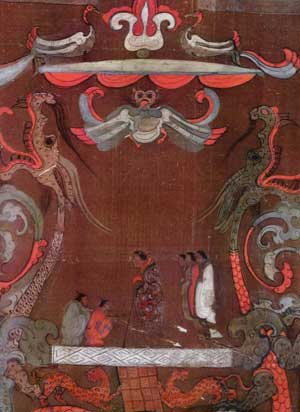 Illustration 4. Mawangdui, Han tomb no. 1, detail of coloured painting on silk (bohua). 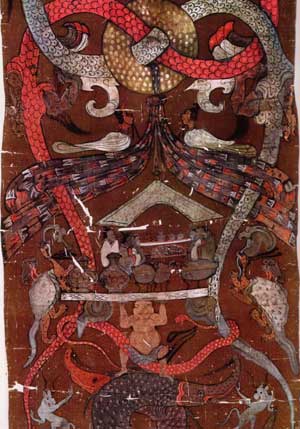 Illustration 5. Mawangdui, Han tomb no. 1, detail of coloured painting on silk (bohua).
Illustration 5. Mawangdui, Han tomb no. 1, detail of coloured painting on silk (bohua).
It should be pointed out that this is only the first volume of the report on tombs nos. 2 and 3, and that it also only contains transcripts of the inscribed bamboo slips, descriptions of the maps on silk, and an outline of the titles of the documents on silk. The reproduction of the documents on silk in their entirety will appear in a second volume yet to be published. However, the failure to publish officially the silk manuscripts and bamboo slips has not prevented scholars having access to reproductions of these important documents, and this report is invaluable for its 100 page bibliography which lists all books and articles, many of them addressing the silk manuscripts, which have been published over the past 30 years. Of course, the interpretation, translation and elucidation many of these documents have been conducted by such foremost international scholars as Jao Tsung-i, Edward Shaughnessy and Mark Malinowski, and many of the most important works can now be found in English translation with full exegesis. Regrettably, while the bibliography in the report cites this scholarship, it fails to supply the original names of most overseas scholars and provides no imprint details of foreign books, journals or articles titles or details in their original published languages. It is to be hoped that there is not too great a delay in the publication of the second volume, which will serve as a useful volume bringing all the manuscripts together for the first time. 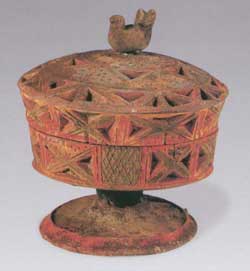 Illustration 6. Mawangdui, Han tomb no. 2, pottery censer (xunlu).
Illustration 6. Mawangdui, Han tomb no. 2, pottery censer (xunlu).
The 30-year wait for the excavation report of tombs nos. 2 and 3 highlights the tardiness that often now characterises the publication of this type of document. The two-volume report on tomb no. 1 which appeared in 1973 is a superb publication of high quality, suggesting recourse to the best printing technology available in China at that time. However, Mao Zedong was, of course, still alive, and this excavation was conducted in Hunan, his home province. The colophon of the work is larded with quotations from Mao Zedong in bold type, so no expense in its production would have been spared. The newly published report is not of the same quality as the 1973 report, and the photographic quality of some of the plates is poor. (see Illustrations 6 and 7) Over the 1980s and 1990s, the quality of excavation reports published in China became very uneven. The two-volume report on the excavation of the Cuo tomb of the Zhongshan kingdom in Hebei, published by Cultural Relics Publishing House in 1985, is of a particularly poor standard. As the costs of printing spiralled, many archaeological institutes could no longer rely on the expensive Cultural Relics Publishing House to publish and print their reports. Science Press and Daxiang Chubanshe have instead attracted many customers, given their cheaper costs. There was also an increasing scarcity of specialist editors at Cultural Relics Publishing House capable of handling archaeological excavation reports. The late 1990s also saw a tendency in some excavation reports to prettify artefacts and enhance them artistically, either in line drawings or in photographs, a regrettable trend best exemplified by the excavation report for the Sanxingdui sacrificial pits (Cultural Relics Publishing House, 1999). (I hasten to add that the publishers of the 1973 Mawangdui report probably had recourse to hand tinting in preparing their colour plates.) This questionable approach is at odds with the traditional use in archaeological reports of undistorted frontal photography without distorting shadows, augmented by faithful diagrams and line drawings from different elevations. 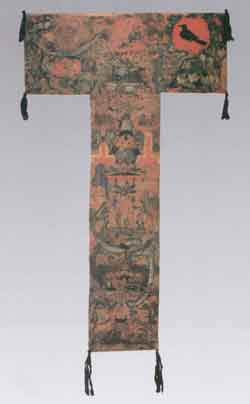 Illustration 7. Mawangdui, Han tomb no. 3, painting on silk (bohua) found in coffin no. 1.
Illustration 7. Mawangdui, Han tomb no. 3, painting on silk (bohua) found in coffin no. 1.
The authors of the newly published report have also benefited from the hindsight of three decades of interpretation of the material in all three tombs: the expression of early Han dynasty reality represented by the burials and the paintings on the outer walls of the outer coffins; the relationship between the "inventory" slips and the unearthed objects; the meanings of the paintings on silk; the categories of object that the paintings on silk actually are; and the society of the little known Changsha state which produced such tombs for its ruling families. For example, the T-shaped painting on silk found in tomb no. 3 (see Illustration 7), similar to the example found in tomb no. 1, is not described in the new report as a possible flag or hanging pennant but rather is named the "feiyi" painting, in recognition of the fact that it is listed under that name in the inventory of funeral goods (qiance) inscribed on bamboo slips and found in the tomb. Today most scholars believe that the T-shaped paintings were not hangings but rather shrouds (yiqin) used to cover the coffin, as they were indeed when unearthed. In the Qin-Han period, ritual documents describe how during the preparation of the body for burial the yiqin was used to cover the corpse after the first stage of dressing (xiaolian) had been completed and before the second stage of dressing (dalian) the corpse had been performed; when the second stage of dressing was completed, the corpse was placed inside the coffin and the yiqin shroud was used to cover the coffin. Of course, ritual texts can be very inaccurate guides to what archaeology unearths. The excavation of these three tombs remains one of the most significant events in PRC archaeology, and this newly published report enables us to better assess what the excavation of these tombs has revealed. The editors of this new volume have benefited from hindsight. While many of the issues raised by the artefacts have been resolved, other areas are still subject to debate and re-interpretation: the identity of the occupant of tomb no. 3 [1]; the specific date of the burial in tomb no. 3; the meaning of the term feiyi (some scholars suggest that it means "garment for flight"); and the significance of the mural on the western wall of tomb no. 3 which is described alternatively in the new report as "chema yishang tu" (a depiction of horses, carriages and a guard of honour) and "junzhen songzang tu" (a depiction of soldiers taking part in a funeral procession). Issues like these and the interpretation of the many documents found in the tomb will occupy scholars for many years to come. It is to be hoped that the second volume of this report appears in the very near future. [BGD] Notes:[1] Li Shisheng, "Changsha Mawangdui sanhao muzhu zaiyi" (Reflections on the identity of the occupant of tomb no. 3 at Mawangdui, Changsha), Gugong Bowuyuan yuankan, 2005:3 (June 2005). |